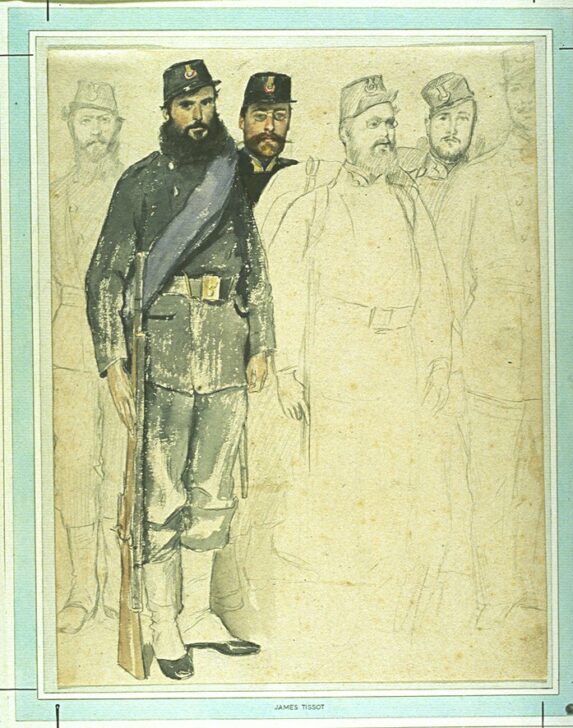Les Éclaireurs de la Seine
James Jacques Joseph Tissot

Description
Gallery Rotation Fall 2010
James Tissot
France, 1836–1902
Les Éclaireurs de la Seine
circa 1870–71
Graphite and watercolor on paper
Museum purchase, 1966/2.4
Tissot is best known for his genre paintings of fashionable and elegant women in London and Paris; this sketch of figures in military attire is something of an anomaly in his work. During the summer of 1870, France declared war on Germany and in autumn and winter of that year Paris was under a state of siege for four months. A number of artists—including Edgar Degas, Édouard Manet, Gustave Courbet, and Tissot—joined the National Guard and remained in Paris to defend the capital. The shortages, isolation, and starvation robbed Paris of its customary attractions, particularly for those used to depicting the modern subjects of cafés and boulevards.
Tissot’s sketch of men in his company is evidence of his skills as a portraitist. Although only two of the figures have been identified, each of the somber figures is a study in seriousness and recalls portrait photographs of soldiers in uniform from the mid-nineteenth century.
Subject Matter:
Tissot depicts six male figures portrayed in the uniforms of éclaireurs, or scouts, of nineteenth- century France. Although his first works were literary and historical, Tissot started painting modern subjects in 1856 when he relocated to Paris. Tissot was in Paris and helped defend the city from the Germans during the Franco-Prussian War. This work likely features portraits of people he knew and perhaps served with and differs from his better known depictions of fashionable women in the city. Tissot fled to England after the fall of the Commune in 1871, where he proceeded to paint portraits and was linked to the aesthetic movement. He lived with a mistress and muse until her death in 1882, when he returned to Paris. He converted to Catholicism three years later and mainly focused on ambitious religious themes.
Physical Description:
This work in graphite and watercolor on off-white wove paper is vertically oriented. There are six standing male figures portrayed in uniforms. Only the second and third men from the left are colored in, the four others are rendered with graphite outlines. The men wear military jackets with belts, trousers, and black shoes with tall, white spats. Their hats have brass emblems and tipped up bills. The largest man who was been colored in has a blue sash over his gray uniform and holds a rifle at his side. There is a pale blue rectangular border around the men with the artist’s name in the bottom center.
Usage Rights:
If you are interested in using an image for a publication, please visit https://umma.umich.edu/request-image/ for more information and to fill out the online Image Rights and Reproductions Request Form.